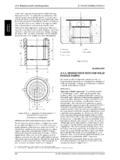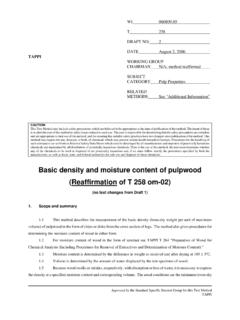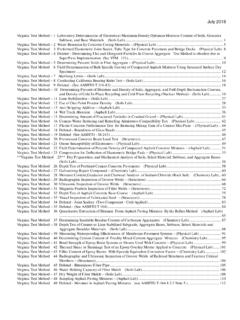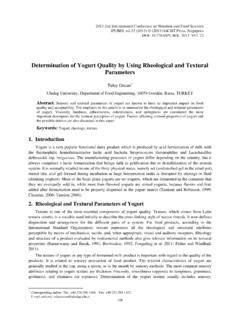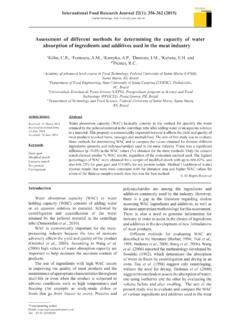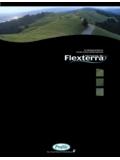Transcription of 5210 BIOCHEMICAL OXYGEN DEMAND (BOD)* …
1 5-2 AGGREGATE ORGANIC CONSTITUENTS (5000). 5210 biochemical oxygen demand (BOD)*. 5210 A. Introduction 1. General Discussion iron and sulfur compounds, or lack of mixing may affect the accuracy and precision of BOD measurements. Presently, there The BIOCHEMICAL OXYGEN DEMAND (BOD) determination is an is no way to include adjustments or corrections to account for the empirical test in which standardized laboratory procedures are effect of these factors. used to determine the relative OXYGEN requirements of wastewa- Oxidation of reduced forms of nitrogen, such as ammonia and ters, effluents, and polluted waters. The test has its widest ap- organic nitrogen, can be mediated by microorganisms and exert plication in measuring waste loadings to treatment plants and in nitrogenous DEMAND .
2 Nitrogenous DEMAND historically has been evaluating the BOD-removal efficiency of such treatment sys- considered an interference in the determination of BOD, and the tems. The test measures the molecular OXYGEN utilized during a inclusion of ammonia in the dilution water contributes an exter- specified incubation period for the BIOCHEMICAL degradation of nal source of nitrogenous DEMAND . The interference from nitrog- organic material (carbonaceous DEMAND ) and the OXYGEN used to enous DEMAND can now be prevented by an inhibitory oxidize inorganic material such as sulfides and ferrous iron. It If an inhibiting chemical is not used, the OXYGEN DEMAND mea- also may measure the amount of OXYGEN used to oxidize reduced sured is the sum of carbonaceous and nitrogenous demands.
3 Forms of nitrogen (nitrogenous DEMAND ) unless their oxidation is prevented by an inhibitor. The seeding and dilution procedures Measurements that include nitrogenous DEMAND generally are not provide an estimate of the BOD at pH to useful for assessing the OXYGEN DEMAND associated with organic Measurements of OXYGEN consumed in a 5-d test period (5-d material. Nitrogenous DEMAND can be estimated directly from am- BOD or BOD5, 5210B), OXYGEN consumed after 60 to 90 d of monia nitrogen (Section 4500-NH3); and carbonaceous DEMAND can incubation (ultimate BOD or UBOD, 5210C), and continuous be estimated by subtracting the theoretical equivalent of the nitrite OXYGEN uptake (respirometric method, 5210D) are described and nitrate produced in uninhibited test results.
4 However, this here. Many other variations of OXYGEN DEMAND measurements method is cumbersome and is subject to considerable error. Chem- exist, including using shorter and longer incubation periods and ical inhibition of nitrogenous DEMAND provides a more direct and tests to determine rates of OXYGEN uptake. Alternative seeding, more reliable measure of carbonaceous DEMAND . dilution, and incubation conditions can be chosen to mimic The extent of oxidation of nitrogenous compounds during the receiving-water conditions, thereby providing an estimate of the 5-d incubation period depends on the concentration and type of environmental effects of wastewaters and effluents. microorganisms capable of carrying out this oxidation.
5 Such The UBOD measures the OXYGEN required for the total degra- organisms usually are not present in raw or settled primary dation of organic material (ultimate carbonaceous DEMAND ) sewage in sufficient numbers to oxidize sufficient quantities of and/or the OXYGEN to oxidize reduced nitrogen compounds (ul- reduced nitrogen forms in the 5-d BOD test. Many biological timate nitrogenous DEMAND ). UBOD values and appropriate ki- treatment plant effluents contain sufficient numbers of nitrifying netic descriptions are needed in water quality modeling studies organisms to cause nitrification in BOD tests. Because oxidation such as UBOD:BOD5 ratios for relating stream assimilative of nitrogenous compounds can occur in such samples, inhibition capacity to regulatory requirements; definition of river, estuary, of nitrification as directed in ) is recommended for or lake deoxygenation kinetics; and instream ultimate carbona- samples of secondary effluent, for samples seeded with second- ceous BOD (UCBOD) values for model calibration.
6 Ary effluent, and for samples of polluted waters. 2. Carbonaceous Versus Nitrogenous BOD. 3. Reference A number of factors, for example, soluble versus particulate organics, settleable and floatable solids, oxidation of reduced 1. YOUNG, 1973. Chemical methods for nitrification control. J. Water Pollut. Control Fed. 45:637. * Approved by Standard Methods Committee, 2001. Joint Task Group: James C. Young (chair), George T. Bowman, Sabry M. Kamhawy, Terry G. Mills, Marlene Patillo, Ray C. Whittemore. 5210 B. 5-Day BOD Test 1. General Discussion it at the specified temperature for 5 d. Dissolved OXYGEN is measured initially and after incubation, and the BOD is com- The method consists of filling with diluted and seeded sample, puted from the difference between initial and final DO.
7 Because to overflowing, an airtight bottle of specified size and incubating the initial DO is determined shortly after the dilution is made, all BIOCHEMICAL OXYGEN DEMAND (BOD) (5210)/5-Day BOD Test 5-3. OXYGEN uptake occurring after this measurement is included in i. Ammonium chloride solution: Dissolve g NH4Cl in the BOD measurement. about 500 mL distilled water, adjust pH to with NaOH. For sampling and storage procedures, see 4a below. solution, and dilute to 1 L. Solution contains mg N/mL. j. Source water for preparing BOD dilution water: Use de- 2. Apparatus mineralized, distilled, tap, or natural water for making sample dilutions (see 4c). a. Incubation bottles: Use glass bottles having 60 mL or greater capacity (300-mL bottles having a ground-glass stopper and a flared mouth are preferred).
8 Clean bottles with a detergent, 4. Preparatory Procedures rinse thoroughly, and drain before use. b. Air incubator or water bath, thermostatically controlled at a. Sampling and storage: Samples for BOD analysis may 20 1 C. Exclude all light to prevent possibility of photosyn- degrade significantly during storage between collection and anal- thetic production of DO. ysis, resulting in low BOD values. 1) Grab samples If analysis is begun within 2 h of collec- 3. Reagents tion, cold storage is unnecessary. If analysis is not started within 2 h of sample collection, keep sample at or below 4 C from the Prepare reagents in advance but discard if there is any sign of time of collection.
9 Begin analysis within 6 h of collection; when precipitation or biological growth in the stock bottles. Commer- this is not possible because the sampling site is distant from the cial equivalents of these reagents are acceptable and different laboratory, store at or below 4 C and report length and temper- stock concentrations may be used if doses are adjusted propor- ature of storage with the results. In no case start analysis more tionally. Use reagent grade or better for all chemicals and use than 24 h after grab sample collection. When samples are to be distilled or equivalent water, preferably sterilized, for making all used for regulatory purposes make every effort to deliver sam- solutions.
10 Ples for analysis within 6 h of collection. a. Phosphate buffer solution: Dissolve g KH2PO4, g 2) Composite samples Keep samples at or below 4 C during K2 HPO4, g Na2 HPO4 7H2O, and g NH4Cl in about 500 compositing. Limit compositing period to 24 h. Use the same mL distilled water and dilute to 1 L. The pH should be criteria as for storage of grab samples, starting the measurement without further adjustment. Alternatively, dissolve g of holding time from end of compositing period. State storage KH2PO4 and g NH4Cl in about 700 mL distilled water. time and conditions as part of the results. Adjust pH to with 30% NaOH and dilute to 1 L. b. Sample preparation and pretreatment: b. Magnesium sulfate solution: Dissolve g MgSO4 7H2O 1) All samples Check pH; if it is not between and , in distilled water and dilute to 1 L.
